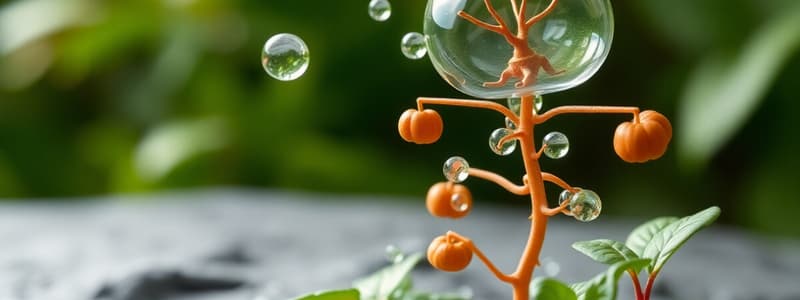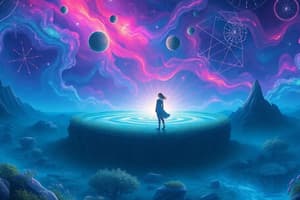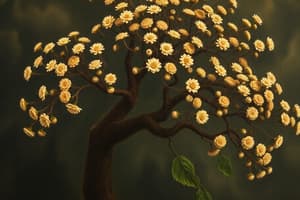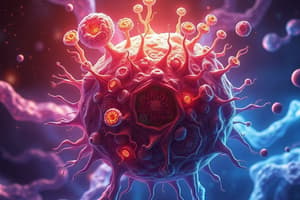Podcast
Questions and Answers
What two components combine to form molecules?
What two components combine to form molecules?
- Organs
- Organelles
- Atoms (correct)
- Tissues
What is the fundamental unit of life?
What is the fundamental unit of life?
- Tissue
- Cell (correct)
- Organ
- Organelle
What is the term for maintaining internal constancy?
What is the term for maintaining internal constancy?
- Homeostasis (correct)
- Metabolism
- Biodiversity
- Evolution
Which of these is a group of the same species living in the same area?
Which of these is a group of the same species living in the same area?
What do primary producers extract from the nonliving environment?
What do primary producers extract from the nonliving environment?
From where do consumers obtain energy and nutrients?
From where do consumers obtain energy and nutrients?
What is the continuous source of energy for most ecosystems?
What is the continuous source of energy for most ecosystems?
What is the result of asexual reproduction?
What is the result of asexual reproduction?
Why is sexual reproduction more successful than asexual reproduction in the long term?
Why is sexual reproduction more successful than asexual reproduction in the long term?
What is the unifying process that relates all living things?
What is the unifying process that relates all living things?
Who is credited with first arguing for evolution through natural selection?
Who is credited with first arguing for evolution through natural selection?
What does the term 'biodiversity' describe?
What does the term 'biodiversity' describe?
What science is used to name and classify organisms?
What science is used to name and classify organisms?
Which domains contain prokaryotic cells?
Which domains contain prokaryotic cells?
What is a key characteristic of eukaryotes?
What is a key characteristic of eukaryotes?
Which kingdom extracts energy as heterotrophs through external digestion?
Which kingdom extracts energy as heterotrophs through external digestion?
In what domain and kingdom are humans classified?
In what domain and kingdom are humans classified?
In the biological classification system, which level comes after Kingdom?
In the biological classification system, which level comes after Kingdom?
What is the first step of the scientific method?
What is the first step of the scientific method?
Why is a hypothesis never proven true?
Why is a hypothesis never proven true?
Which variable is manipulated in an experiment?
Which variable is manipulated in an experiment?
What does a larger sample size indicate about a study?
What does a larger sample size indicate about a study?
How does a hypothesis differ from a scientific theory?
How does a hypothesis differ from a scientific theory?
What is matter composed of?
What is matter composed of?
Which of the following cannot be broken down into other substances by chemical means?
Which of the following cannot be broken down into other substances by chemical means?
What four elements are most abundant in living cells?
What four elements are most abundant in living cells?
What part of an atom identifies the element?
What part of an atom identifies the element?
Where are protons and neutrons located in an atom?
Where are protons and neutrons located in an atom?
What is an atom called when it gains or loses electrons?
What is an atom called when it gains or loses electrons?
What is the mass number of an atom?
What is the mass number of an atom?
What are atoms called that have different numbers of neutrons?
What are atoms called that have different numbers of neutrons?
What pH is considered neutral?
What pH is considered neutral?
Which of the following is a strong acid?
Which of the following is a strong acid?
Cell theory states which of the following?
Cell theory states which of the following?
What encloses the cytoplasm in a cell?
What encloses the cytoplasm in a cell?
What is the fluid portion of the cytoplasm called?
What is the fluid portion of the cytoplasm called?
What is an advantage of small cells?
What is an advantage of small cells?
What does a prokaryotic cell lack?
What does a prokaryotic cell lack?
Which domain contains E. coli?
Which domain contains E. coli?
Which domain includes organisms with eukaryotic cells?
Which domain includes organisms with eukaryotic cells?
What do plant cells have that animal cells lack?
What do plant cells have that animal cells lack?
What provides cells with the ability to do work?
What provides cells with the ability to do work?
What is stored energy available to do work called?
What is stored energy available to do work called?
Which level of biological organization includes both living and nonliving components?
Which level of biological organization includes both living and nonliving components?
What is the science of naming and classifying organisms called?
What is the science of naming and classifying organisms called?
Which of the following domains contains organisms that lack a nucleus?
Which of the following domains contains organisms that lack a nucleus?
What is the variable that a scientist manipulates in an experiment?
What is the variable that a scientist manipulates in an experiment?
What is any material that is composed of atoms and takes up space?
What is any material that is composed of atoms and takes up space?
Flashcards
Atom
Atom
The smallest chemical unit of a pure substance.
Molecule
Molecule
A group of atoms bonded together.
Organelle
Organelle
A membrane-bound structure with a specific function within a cell.
Cell
Cell
Signup and view all the flashcards
Tissue
Tissue
Signup and view all the flashcards
Organ
Organ
Signup and view all the flashcards
Organ System
Organ System
Signup and view all the flashcards
Organism
Organism
Signup and view all the flashcards
Population
Population
Signup and view all the flashcards
Community
Community
Signup and view all the flashcards
Ecosystem
Ecosystem
Signup and view all the flashcards
Biosphere
Biosphere
Signup and view all the flashcards
Homeostasis
Homeostasis
Signup and view all the flashcards
Primary Producers
Primary Producers
Signup and view all the flashcards
Consumers
Consumers
Signup and view all the flashcards
Decomposers
Decomposers
Signup and view all the flashcards
Asexual Reproduction
Asexual Reproduction
Signup and view all the flashcards
Sexual Reproduction
Sexual Reproduction
Signup and view all the flashcards
Evolution
Evolution
Signup and view all the flashcards
Natural Selection
Natural Selection
Signup and view all the flashcards
Biodiversity
Biodiversity
Signup and view all the flashcards
Taxonomy
Taxonomy
Signup and view all the flashcards
Prokaryotes
Prokaryotes
Signup and view all the flashcards
Eukaryotes
Eukaryotes
Signup and view all the flashcards
Plantae
Plantae
Signup and view all the flashcards
Animalia
Animalia
Signup and view all the flashcards
Fungi
Fungi
Signup and view all the flashcards
Protista
Protista
Signup and view all the flashcards
Hypothesis
Hypothesis
Signup and view all the flashcards
Theory
Theory
Signup and view all the flashcards
Matter
Matter
Signup and view all the flashcards
Element
Element
Signup and view all the flashcards
Bulk Elements
Bulk Elements
Signup and view all the flashcards
Trace Elements
Trace Elements
Signup and view all the flashcards
Atomic Number
Atomic Number
Signup and view all the flashcards
Ion
Ion
Signup and view all the flashcards
Mass Number
Mass Number
Signup and view all the flashcards
Isotopes
Isotopes
Signup and view all the flashcards
Molecule
Molecule
Signup and view all the flashcards
Cell Theory
Cell Theory
Signup and view all the flashcards
Structures Common to All Cells
Structures Common to All Cells
Signup and view all the flashcards
Cytosol
Cytosol
Signup and view all the flashcards
Potential Energy
Potential Energy
Signup and view all the flashcards
Kinetic Energy
Kinetic Energy
Signup and view all the flashcards
Law of Energy Conservation
Law of Energy Conservation
Signup and view all the flashcards
Second Law of Thermodynamics
Second Law of Thermodynamics
Signup and view all the flashcards
Study Notes
Matter and Life's Organization
- All matter, living and non-living, comprises atoms that combine into molecules.
- Living organisms are intricate molecular collections, sustained by energy and chemical reactions.
- Science explores the universe, but alternative methods exist for investigating mysteries.
- Homeostasis is the maintenance of stable internal conditions.
Levels of Biological Organization
-
Atom: Smallest unit of a pure substance.
-
Molecule: Group of atoms.
-
Organelle: Membrane-bound structure with a specific function inside a cell.
-
Cell: The fundamental unit of life.
-
Tissue: Coordinated collection of specialized cells.
-
Organ: Organized tissues performing specific functions.
-
Organ System: Physically or chemically connected organs working together.
-
Organism: A single, living individual.
-
Population: Group of the same species in the same area/time.
-
Community: All populations in the same region.
-
Ecosystem: Living and non-living components of an area.
-
Biosphere: The global ecosystem, encompassing all life-supporting areas of the planet.
Energy and Life
- Energy sustains life by maintaining organization, growth, development, and reproduction (homeostasis).
- Energy transfers are inefficient, with some energy lost as heat.
- Primary producers extract energy and nutrients from the nonliving environment.
- Consumers obtain energy and nutrients by consuming other organisms.
- Decomposers get nutrients from dead organisms and organic waste.
- The sun serves as the continuous energy source for most ecosystems.
Reproduction and Evolution
- Asexual reproduction involves one parent producing genetically identical offspring.
- Sexual reproduction involves two parents, resulting in genetically diverse offspring.
- Sexual reproduction is more successful due to the increased diversity, enhancing survival in changing environments.
- Evolution unifies all life, indicating all living things are related.
- Charles Darwin proposed the theory of evolution through natural selection in "On the Origin of Species" (1859).
- Natural selection is a mechanism of evolution, explaining genetic changes in populations.
- Alfred Wallace co-discovered natural selection.
Biodiversity and Classification
- Biodiversity refers to the variety of life on Earth, from animals to microorganisms.
- Biodiversity is vital for thriving life on Earth as it impacts food, water, and medicines.
- Taxonomy classifies and names life, revealing evolutionary relationships.
- Life's diversity includes Bacteria and Archaea domains and Eukaryotes domains (protista, animalia, fungi, and plantae).
- Prokaryotes are unicellular organisms lacking a nucleus.
- Eukaryotes can be unicellular or multicellular and have a nucleus.
Domain and Kingdom Examples
-
Plantae: Multicellular autotrophs and heterotrophs.
-
Animalia: Multicellular heterotrophs (ingestion).
-
Fungi: Mostly multicellular heterotrophs (external digestion).
-
Protista: Single-celled and multicellular autotrophs.
-
Humans are in the Domain Eukarya and Kingdom Animalia.
Taxonomy
- The eight biological classifications of taxonomy are: Domain, Kingdom, Phylum, Class, Order, Family, Genus, Species.
- An easy way to remember the classification order is: Dear King Phillip Came Over For Good Soup.
Scientific Method
- The scientific method consists of observation, hypothesis, prediction, testing, data analysis, and conclusion.
- A testable hypothesis can be either supported or refuted through data analysis.
- A hypothesis is never proven true because new evidence may contradict current observations.
Experiment Variables & Data Integrity
- Independent variable: Manipulated to observe changes.
- Dependent variable: Measured to see if it responds to change.
- Standardized variable: Kept constant.
- Control: Used for comparison.
- Larger sample sizes are more credible.
Differences between Hypothesis & Theory
- A hypothesis is an educated guess that can be tested.
- A theory is a well-supported explanation based on previous testing.
- Widely accepted theories are considered facts.
Matter and Elements
- Matter is any material that is composed of atoms and takes up space, living and nonliving.
- Elements cannot be broken down chemically (e.g., hydrogen, carbon, nitrogen, oxygen).
- 25 elements are essential for life.
- The four most abundant elements in living cells are carbon, hydrogen, oxygen, and nitrogen.
- Trace elements are required in small amounts (e.g., iron and zinc).
Atomic Structure
- Atoms are the smallest unit of an element, identified by their proton number.
- The nucleus contains protons (positive charge) and neutrons (no charge).
- Electrons (negative charge) exist outside the nucleus.
- The atomic number equals the number of protons.
- Atoms gain or lose electrons, becoming ions (charged atoms): gaining electrons results in a negative charge, loss results in a positive charge.
- The mass number is the sum of protons and neutrons in the nucleus.
- An atom is the smallest unit of matter, while an element is a pure substance of one type of atom.
Isotopes & Molecules
- Isotopes are atoms with differing numbers of neutrons.
- Radioactive isotopes emit particles/rays as their nucleus disintegrates, used in imaging/research.
- Molecules are two or more atoms joined together, of the same or different elements (e.g., CH4).
pH Balance
- Living cells maintain a specific pH level involving hydrogen atoms.
- pH 7 is neutral, higher pH is basic, lower pH is acidic.
- Lemon juice is a strong acid; bleach is a strong base; water is neutral.
- Cells of living organisms have the same chemical building blocks that are biological or organic molecules.
- Carbohydrates, proteins, nucleic acids, and lipids make up building blocks.
- Polymers are fundamental building blocks of larger molecules, with subunits (monomers) held by chemical bonds.
- Thousands of different combinations of around 20 amino acids can produce different polypeptides.
Cell Theory
- Cell theory states that all organisms have cells, cells are fundamental units of life, and cells come from pre-existing cells.
- All cells have DNA, RNA, a plasma membrane, cytosol, ribosomes, and cytoplasm.
- Cytoplasm is enclosed by the plasma membrane, cytosol is the fluid portion of the cytoplasm.
- Small cells have a higher surface area to volume ratio.
- Having cell contents close to the surface allows for faster nutrient, oxygen, and waste exchange.
Prokaryotic Cells
- Prokaryotes lack a nucleus and membrane-bound organelles and are unicellular and smaller than eukaryotes.
- Bacteria are abundant and diverse, the oldest organisms, and have a protective cell wall.
- The DNA sits in the nucleoid.
- Archaea share characteristics with bacteria and eukaryotes but have unique structures and chemistry and are more closely related to eukaryotes than bacteria.
Eukaryotic Cells
- Eukaryotes have a true nucleus and are larger than prokaryotic cells.
- They have a cytoskeleton of protein.
- Eukaryotes are unicellular or multicellular.
- Domain Eukarya includes protista, animalia, plantae, and fungi.
- Organelles are structures inside cells with specific functions, many enclosed by membranes.
- Only eukaryotic cells contain membrane-bound organelles.
- Organelles consist of macromolecules: carbohydrates, lipids, proteins, DNA, and RNA.
- Plant cells have a cell wall and chloroplasts, which animal cells lack.
Energy and Thermodynamics
- Energy is the ability to do work.
- Cells need to replenish energy to maintain their many chemical reactions.
- Potential energy is stored energy available for work.
- Kinetic energy is the energy of motion.
- Cellular respiration is the process of all living things, including plants; uses to transform one form to another.
- Energy cannot be created or destroyed, only transformed (1st law of thermodynamics).
- All energy transformations are inefficient, losing energy as heat (2nd law of thermodynamics).
- Heat energy, disordered from random molecular movements, increases entropy (randomness).
Entropy
- Organisms are highly organized, requiring a constant energy stream to maintain organization.
- They release heat and disordered waste products; consequently increasing entropy.
- Metabolism includes all chemical reactions inside cells, consuming or generating energy.
- Each reaction rearranges atoms, requiring or releasing energy.
- ATP (adenosine triphosphate) is a usable energy source for cells, similar to DNA/RNA nucleotides.
- ATP comprises three phosphate groups, adenine (base), and ribose (sugar).
- Energy is stored in the chemical bonds connecting the three phosphate groups.
- The cell instead stores energy rich molecules (fats, starch, and glycogen) because ATP is too unstable for long-term storage.
Energy Creation
- ADP (adenosine diphosphate) restores ATP by taking in energy from the environment.
- ATP hydrolysis is energy input from food and ATP synthesis is energy available for work.
- Metabolic pathways transform energy.
Autotrophs vs Heterotrophs
- The sun is the ultimate energy source in most ecosystems - Autotrophs transform inorganic substances into organic compounds.
- Heterotrophs obtain carbon by consuming pre-existing molecules.
- Autotrophs include plants, algae, and bacteria.
- Heterotrophs include animals, fungi, and bacteria.
Photosynthesis
- Photosynthesis converts light energy to potential energy in glucose bonds.
- The chloroplast is the site for photosynthesis, which requires energy.
- The sun serves as the energy source for photosynthesis.
- Glucose stores the potential energy at the end of photosynthesis.
- Photosynthesis affects humans by releasing oxygen and being the vital food supply source.
Photosynthesis Equation
- The equation for photosynthesis is carbon dioxide + water + light energy = glucose + oxygen.
- 6CO2 + 6H2O + light energy = C6H12O6 + 6O2
- The spectrum allows organisms to transform inorganic substances into organic compounds.
- Electromagnetic radiation consists of photons, kinetic energy packets traveling in waves.
- The chloroplast captures light energy.
- Plants or algae need light, water, and carbon dioxide for photosynthesis.
- Leaves are the main organs of photosynthesis in plants.
- Water enters a plant through its roots.
- Gas exchange (CO2 in, O2 out) happens through the stoma (openings in leaves or stems).
- Chloroplasts are the site for photosynthesis.
Cellular Respiration
- Cellular respiration is also known as Aerobic respiration which requires oxygen and produces ATP by converting potential energy.
- Cells continuously creating it since it powers almost all activities.
- The equation for cellular respiration is C6H12O6 + 6O2 = 6CO2 + 6H2O + energy (36 ATP)
The Cycle of Life
-
Photosynthesis and cellular respiration are connected through the products of photosynthesis and the reactants of cellular respiration.
-
Mitochondria is the site for cellular respiration.
-
Some cellular respiration energy is stored in ATP, some is released as heat.
-
Plants carry out both photosynthesis (generates carbohydrates) and cellular respiration (generates ATP).
Studying That Suits You
Use AI to generate personalized quizzes and flashcards to suit your learning preferences.



